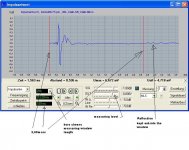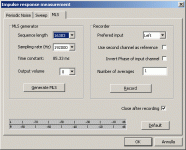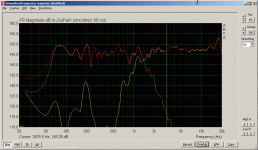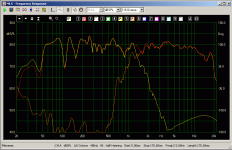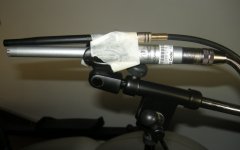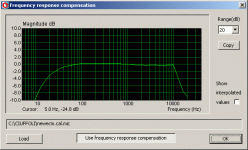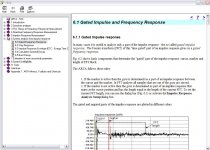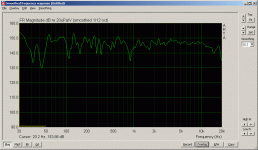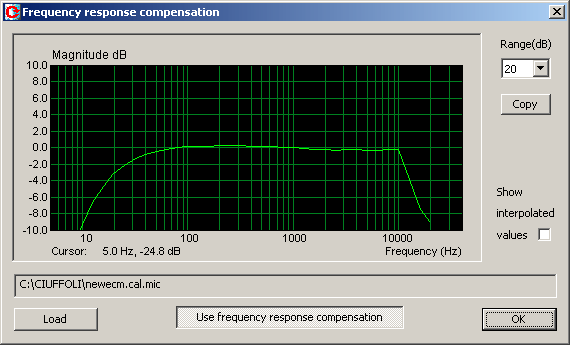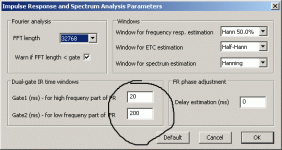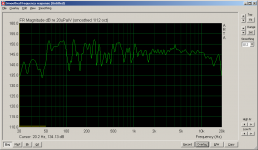What you think about the BEHRINGER ECM8000 as reference mic. because probably I cannot use the Clio mic. with EMU 0404 ?
You'll probably want a calibrated ECM8000 (or similar). Search the forum and the web to find one.
With a behringer emc8000 the chance is huge that you will have a perfect flat response and phase up to around 10khzin this region they can have non linearity it even can be that it is very flat up to 20kHz.I can calibrate it because I can use the Clio system & Clio mic. like reference.
And like you said you can compare to your clio system.
And when measuring in room with a 80msec window will only give a faulty result.
What you think about the BEHRINGER ECM8000 as reference mic. because probably I cannot use the Clio mic. with EMU 0404 ?
Here my phantom supply mic preamp I am using works great. Build with parts I already had.
Hart of the preamp is the opa 2604 a precision op-amp designed for frequency analysers.
http://focus.ti.com/lit/ds/sbos006/sbos006.pdf
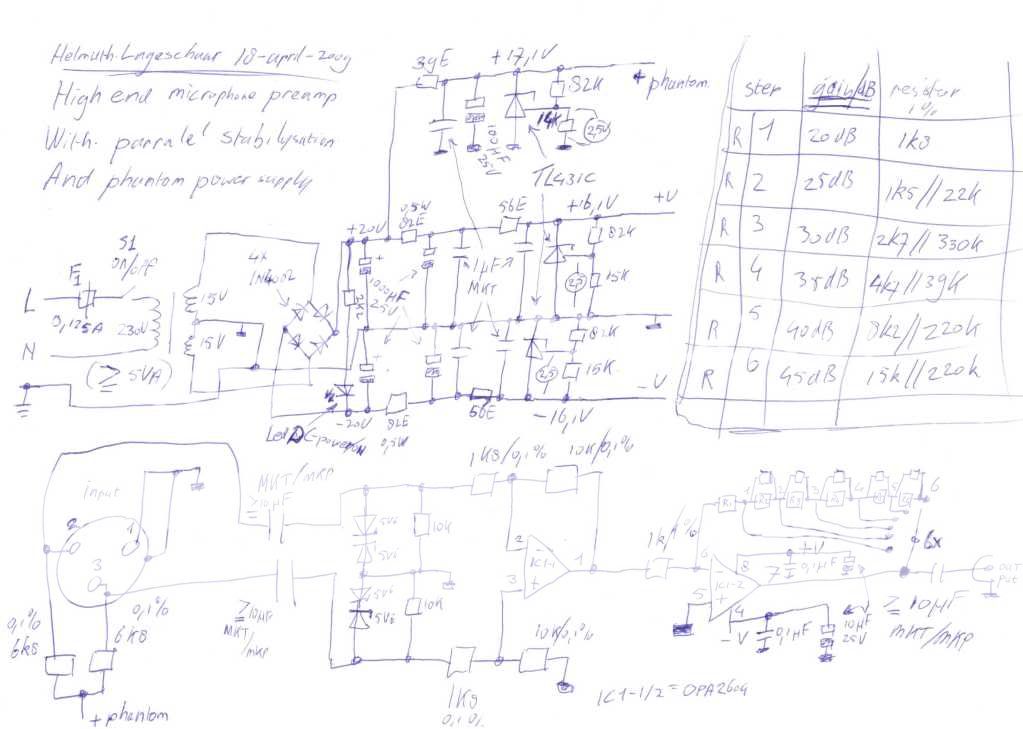

Last edited:
Calibrated emc8000 where to buy.
http://www.cross-spectrum.com/cslmics/001_mic_report.pdf
Cross·Spectrum - Calibrated Behringer ECM8000 Microphones for Sale
Good sound card with phantom input.
http://www.m-audio.com/products/en_us/FastTrackUltra.html
Specifications
All specs measured at 48kHz sampling rate unless otherwise stated
Mic Inputs (A/D)
Input Impedance 1.7k ohms unbalanced, 3.4k ohms balanced
Maximum Input Level from +21dBu @ min gain (with pad) to -50dBu @ max gain (no pad)
Channel-to-Channel Crosstalk < -110dB
SNR (min gain, no pad) -103dB, A-weighted
Dynamic Range (min gain, no pad) 103dB, A-weighted
THD+N (min gain, no pad) 0.002% (-94dB) @ -1dBFS, 1kHz
Frequency Response 20Hz to 20kHz, +/- 0.1dB
Preamp Gain > 60dB
Pad -20dB
Instrument Inputs (A/D)
Input Impedance 1M ohm, unbalanced
Maximum Input Level from +14dBV @ min gain (no pad) to -40dBV @ max gain (no pad)
SNR (min gain, no pad) -103dB, A-weighted
Dynamic Range (min gain, no pad) 103dB, A-weighted
THD+N (min gain, no pad) 0.005% (-86dB) @ -1dBFS, 1kHz
Frequency Response 20Hz to 20kHz, +/- 0.1dB @ 48kHz sample rate
Preamp Gain >45dB
Pad -20dB
Line Inputs (A/D)
Input Impedance 28k ohm balanced / 20k ohm unbalanced
Maximum Input Level +3.4dBu, balanced/+1.2dBV, unbalanced
Channel-to-Channel Crosstalk < -110dB
SNR -103dB, A-weighted
Dynamic Range 103dB, A-weighted
THD+N 0.002% (-94dB) @ -1dBFS, 1kHz
Frequency Response 20Hz to 20kHz, +/- 0.1dB
Input Inserts (analog)
Maximum Level Send +6dBV, unbalanced
Maximum Level Return +6dBV, unbalanced
THD+N 0.002% (-94dB) @ -1dB from max level, 1kHz
Frequency Response 20Hz to 20kHz, +/- 0.1dB
Line Outputs (D/A)
Output Impedance 150 ohms, unbalanced / 300 ohms, balanced
Maximum Output Level +10dBu, balanced
+1.8dBV, unbalanced
Channel-to-Channel Crosstalk < -100dB
SNR -104 dB, A-weighted
Dynamic Range 104dB, A-weighted
THD+N 0.002% (-94dB) @ -1dBFS, 1kHz
Frequency Response 20Hz to 20kHz, +/- 0.1dB
Headphone Output (D/A)
Maximum Output 0dBV at THD < 0.05% into 32 ohms
Channel-to-Channel Crosstalk < -55dB
Frequency Response 20Hz to 20kHz, +/- 0.7dB
Working Range 24 to 600 ohms
http://www.cross-spectrum.com/cslmics/001_mic_report.pdf
Cross·Spectrum - Calibrated Behringer ECM8000 Microphones for Sale
Good sound card with phantom input.
An externally hosted image should be here but it was not working when we last tested it.
http://www.m-audio.com/products/en_us/FastTrackUltra.html
Specifications
All specs measured at 48kHz sampling rate unless otherwise stated
Mic Inputs (A/D)
Input Impedance 1.7k ohms unbalanced, 3.4k ohms balanced
Maximum Input Level from +21dBu @ min gain (with pad) to -50dBu @ max gain (no pad)
Channel-to-Channel Crosstalk < -110dB
SNR (min gain, no pad) -103dB, A-weighted
Dynamic Range (min gain, no pad) 103dB, A-weighted
THD+N (min gain, no pad) 0.002% (-94dB) @ -1dBFS, 1kHz
Frequency Response 20Hz to 20kHz, +/- 0.1dB
Preamp Gain > 60dB
Pad -20dB
Instrument Inputs (A/D)
Input Impedance 1M ohm, unbalanced
Maximum Input Level from +14dBV @ min gain (no pad) to -40dBV @ max gain (no pad)
SNR (min gain, no pad) -103dB, A-weighted
Dynamic Range (min gain, no pad) 103dB, A-weighted
THD+N (min gain, no pad) 0.005% (-86dB) @ -1dBFS, 1kHz
Frequency Response 20Hz to 20kHz, +/- 0.1dB @ 48kHz sample rate
Preamp Gain >45dB
Pad -20dB
Line Inputs (A/D)
Input Impedance 28k ohm balanced / 20k ohm unbalanced
Maximum Input Level +3.4dBu, balanced/+1.2dBV, unbalanced
Channel-to-Channel Crosstalk < -110dB
SNR -103dB, A-weighted
Dynamic Range 103dB, A-weighted
THD+N 0.002% (-94dB) @ -1dBFS, 1kHz
Frequency Response 20Hz to 20kHz, +/- 0.1dB
Input Inserts (analog)
Maximum Level Send +6dBV, unbalanced
Maximum Level Return +6dBV, unbalanced
THD+N 0.002% (-94dB) @ -1dB from max level, 1kHz
Frequency Response 20Hz to 20kHz, +/- 0.1dB
Line Outputs (D/A)
Output Impedance 150 ohms, unbalanced / 300 ohms, balanced
Maximum Output Level +10dBu, balanced
+1.8dBV, unbalanced
Channel-to-Channel Crosstalk < -100dB
SNR -104 dB, A-weighted
Dynamic Range 104dB, A-weighted
THD+N 0.002% (-94dB) @ -1dBFS, 1kHz
Frequency Response 20Hz to 20kHz, +/- 0.1dB
Headphone Output (D/A)
Maximum Output 0dBV at THD < 0.05% into 32 ohms
Channel-to-Channel Crosstalk < -55dB
Frequency Response 20Hz to 20kHz, +/- 0.7dB
Working Range 24 to 600 ohms
Last edited:
I use a cheep 16 bit soundcard cost 30 euro 😀: very good to measure speakers. Real Plug and play. Behringer uca202
In case I would blow it with impedance measurement it isn't bad to throw it away.


In case I would blow it with impedance measurement it isn't bad to throw it away.
An externally hosted image should be here but it was not working when we last tested it.

Last edited:
Great news
Your 24bit soundcard already supports phantom power supply input.!!
Only thing buy a emc8000.
Your 24bit soundcard already supports phantom power supply input.!!
Only thing buy a emc8000.
Are you using Arta software ?
No I use Hobbybox V6 it is only in german and you have to pay for it.
HBX6
An externally hosted image should be here but it was not working when we last tested it.
An externally hosted image should be here but it was not working when we last tested it.
An externally hosted image should be here but it was not working when we last tested it.
It can measure TS-parameters of your driver.

An externally hosted image should be here but it was not working when we last tested it.
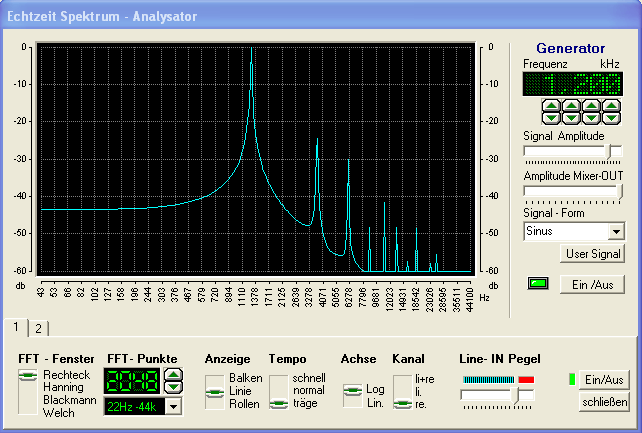
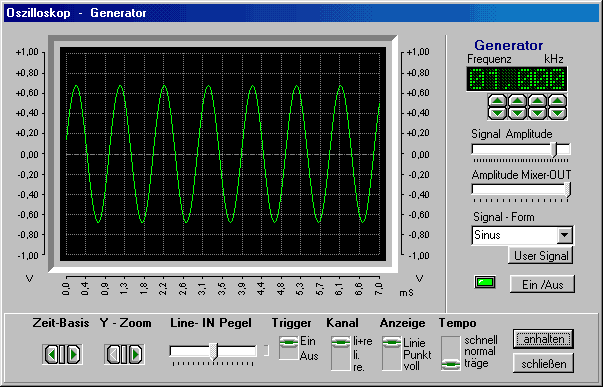
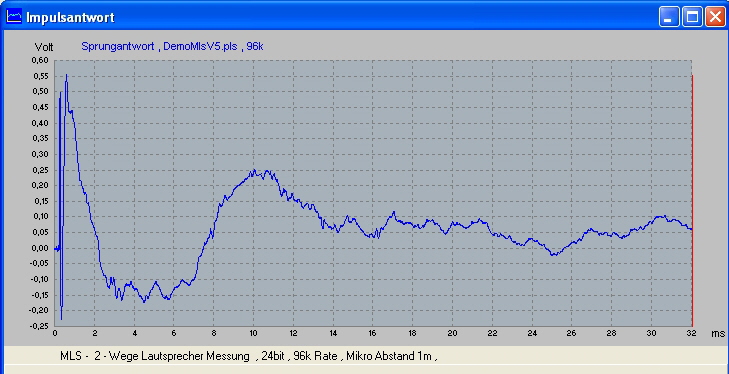
An externally hosted image should be here but it was not working when we last tested it.
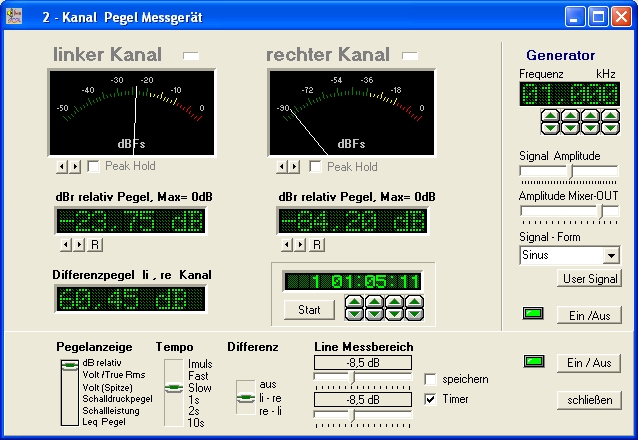
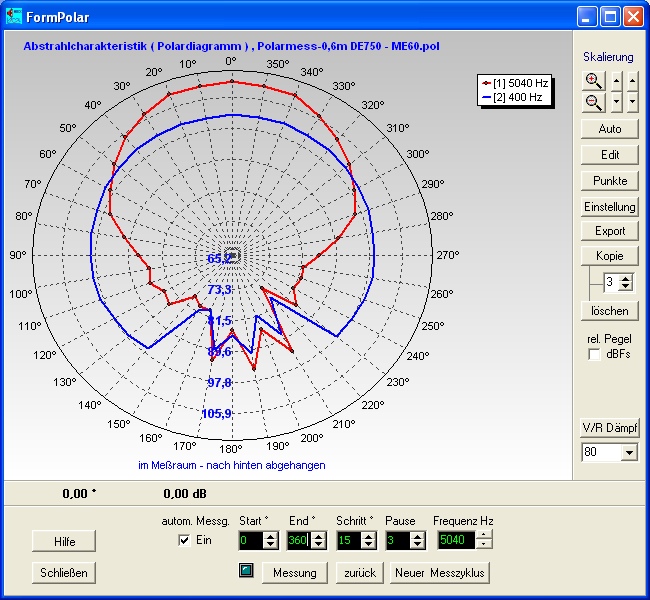
An externally hosted image should be here but it was not working when we last tested it.
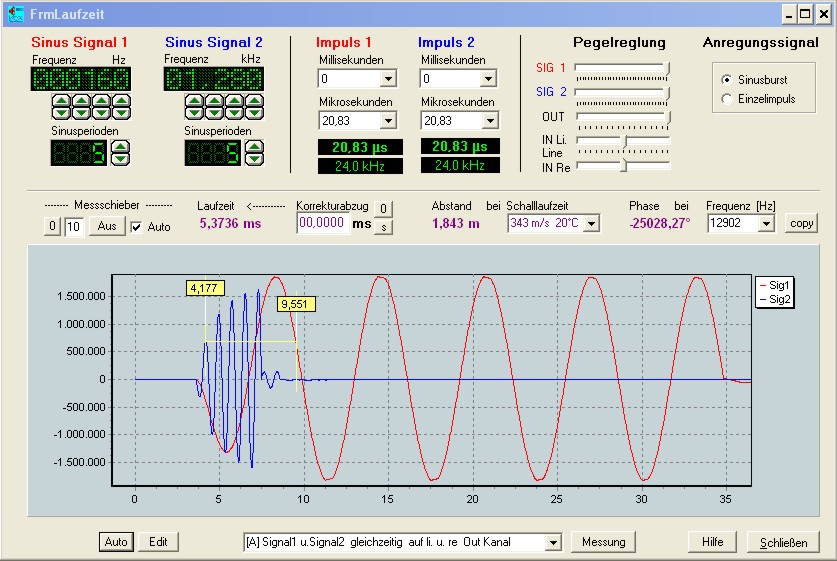
I can do one measurement and look at it in different window length without measuring again.
Distortion measurement in % or dB or at 1 frequency.
DB
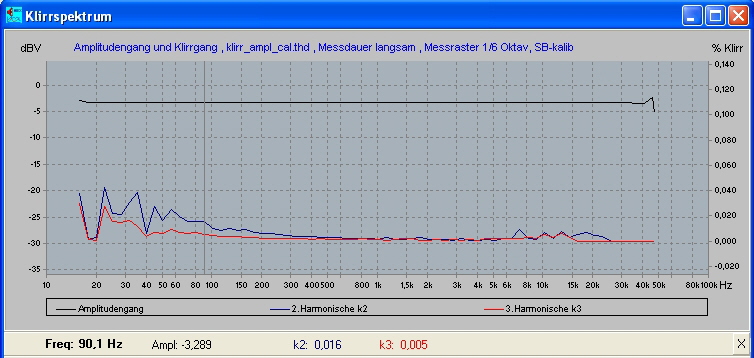
On one bad frequency that you want to explore higher order distorsion. Like your clio you can also use it for amplifiers.
You can paste two responses who you saved. Like I explained with a short window for high frequencies and longer window for low frequencies.
spl with phase step response impulse response. It is very complete with many custom adjustable layout possibilities.
Step response

Distortion measurement in % or dB or at 1 frequency.
DB

On one bad frequency that you want to explore higher order distorsion. Like your clio you can also use it for amplifiers.
An externally hosted image should be here but it was not working when we last tested it.
You can paste two responses who you saved. Like I explained with a short window for high frequencies and longer window for low frequencies.
spl with phase step response impulse response. It is very complete with many custom adjustable layout possibilities.
Step response

Attachments
Last edited:
1.5meters
Clio 8 + mic 01
Sampling 48KHz
Size 8K
Window Hanning/2
Averages 5
170msec
Arta + EMU0404 USB + ECM8000
Sampling 192KHz
Sequence length 32767
Averages 5
Size FFT 8K
170msec
I don't know if the calibration file used for ECM is ok
Clio 8 + mic 01
Sampling 48KHz
Size 8K
Window Hanning/2
Averages 5
170msec
Arta + EMU0404 USB + ECM8000
Sampling 192KHz
Sequence length 32767
Averages 5
Size FFT 8K
170msec
I don't know if the calibration file used for ECM is ok
Attachments
This is the measurement with dual gate FR
200msec for low freq, min value 70msec
20msec for high freq. min value 5msec
70 msec means that we wait for wave lengths of 24meter. do not now how big your room is?😀
To get a refection of the floor 1.5mtr s enough 4.3msec. to get a reflection of the sealing 3mtr is enough 8.7msec.
so to calculate how long it takes for a reflection to be measured. You calculate the distance the wave has to travel in mtr.
then: travel distance in mtr / 344 = sec
- Home
- Loudspeakers
- Multi-Way
- Hi-End and Hi-Efficency loudspeakers (horn + onken)
